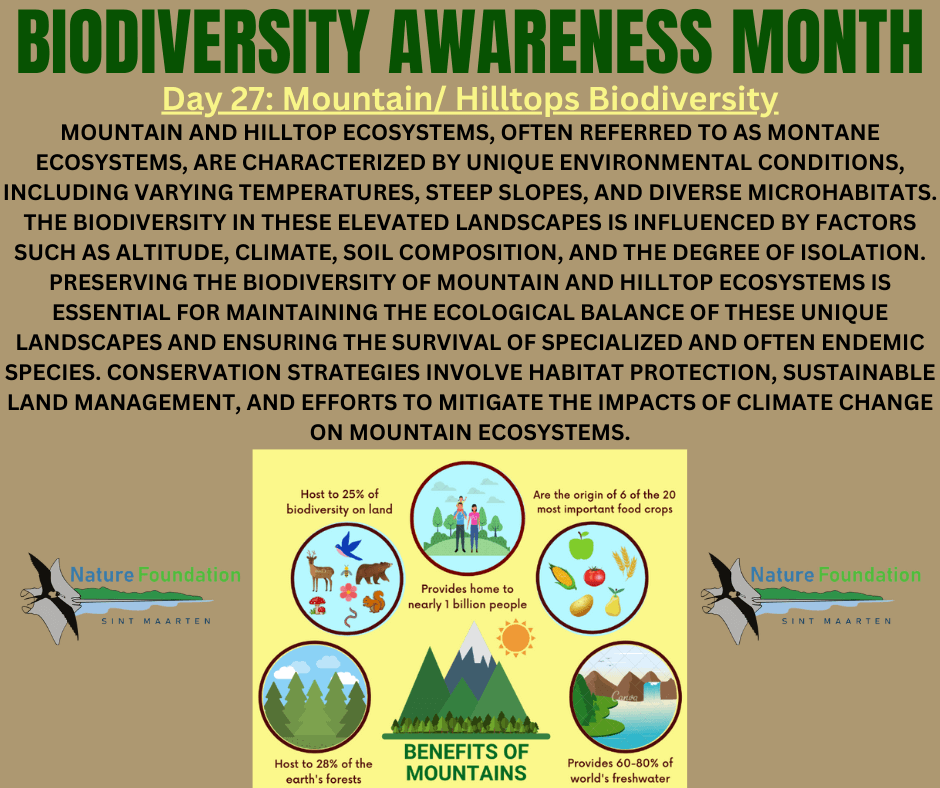Biodiversity month day 27: Mountain/ Hilltops Biodiversity
The St. Maarten Hospitality & Trade Association supports the March Biodiversity awareness month organized by the Nature Foundation in an effort to help protect St. Maartens nature and biodiversity. Todays topic: Mountain/ Hilltops Biodiversity
Mountain and hilltop ecosystems, often referred to as montane ecosystems, are characterized by unique environmental conditions, including varying temperatures, steep slopes, and diverse microhabitats. The biodiversity in these elevated landscapes is influenced by factors such as altitude, climate, soil composition, and the degree of isolation. Here are key aspects of biodiversity in mountain and hilltop ecosystems:
1. Altitudinal Zonation:
Mountains exhibit distinct altitudinal zones, each characterized by specific vegetation types and associated wildlife. These zones often include the subalpine, alpine, and nival zones, each with its own set of adapted plant and animal species.
2. Plant Diversity:
Alpine Flora: The alpine zone, found at higher elevations, is characterized by hardy plants adapted to cold temperatures and short growing seasons. Examples include alpine flowers, mosses, and lichens.
Tree Line: The tree line marks the upper limit of tree growth. Above this line, conditions become too harsh for trees to thrive, giving way to alpine meadows and rockier terrain.
3. Adaptations to Harsh Conditions:
Plants and animals in mountain ecosystems have evolved various adaptations to cope with harsh environmental conditions, including cold temperatures, strong winds, and thin air. Examples include cushion plants that reduce exposure to wind and animals with thick fur or feathers for insulation.
4. Endemic Species:
Mountains often harbor endemic species, which are unique to specific mountain ranges. Isolation and distinct environmental conditions contribute to the evolution of species found only in certain mountain ecosystems.
5. Wildlife Diversity:
Mammals: Mountainous regions support a variety of mammals, including herbivores like mountain goats and sheep.
Birds: Many bird species are adapted to mountain habitats, including raptors like falcons, as well as ground-dwelling birds such as doves.
Invertebrates: Insects and other invertebrates are also diverse in mountain ecosystems, with unique adaptations to the cold and variable conditions.
6. Microclimates and Heterogeneity:
Mountains exhibit microclimates due to variations in slope, aspect, and elevation. This heterogeneity contributes to increased biodiversity, as different species can find suitable niches within these microclimates.
7. Biotic Interactions:
Biotic interactions in mountain ecosystems are often intricate. For example, plant-pollinator relationships may involve specialized adaptations due to the scarcity of pollinators at higher elevations.
8. Threats to Biodiversity:
Mountain ecosystems face threats from climate change, habitat fragmentation, human activities such as logging and infrastructure development, and invasive species. These threats can impact the delicate balance of mountain biodiversity.
9. Tourism and Conservation Challenges:
Mountainous regions are often popular tourist destinations for hiking. Sustainable tourism practices are crucial to minimize negative impacts on biodiversity and ecosystems. Conservation efforts focus on preserving unique species and habitats.
10. Global Importance:
Mountain ecosystems are of global importance as they contribute to biodiversity, regulate water flow to lower elevations, and play a role in climate regulation. The loss of biodiversity in mountains can have cascading effects on ecosystems at lower elevations.
Preserving the biodiversity of mountain and hilltop ecosystems is essential for maintaining the ecological balance of these unique landscapes and ensuring the survival of specialized and often endemic species. Conservation strategies involve habitat protection, sustainable land management, and efforts to mitigate the impacts of climate change on mountain ecosystems.
Back to the Visit St Maarten Main page

